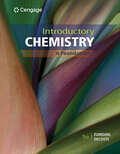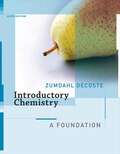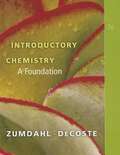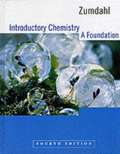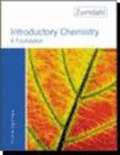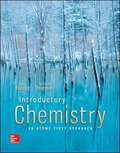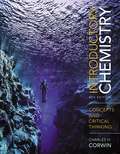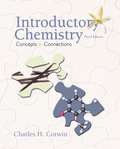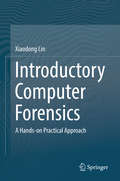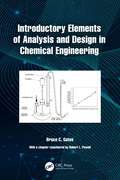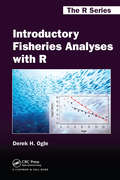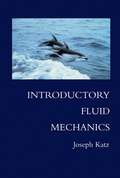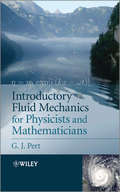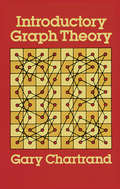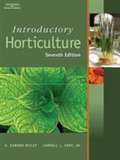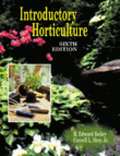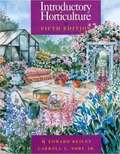- Table View
- List View
Introductory Chemistry: A Foundation
by Steven S. Zumdahl Donald J. DeCosteSucceed in your course with INTRODUCTORY CHEMISTRY: A FOUNDATION! This best-selling text combines enhanced problem-solving structure with substantial pedagogy to help you become a successful problem solver. Early coverage of chemical reactions, accessible explanations and visualizations, and an emphasis on everyday applications facilitates understanding. The authors' step-by-step approach has already helped hundreds of thousands of student's master chemical concepts and develop strong problem-solving skills. Interactive study aids in OWLv2, such as ChemWork Problems and Adaptive Learning Activities, help students master concepts.
Introductory Chemistry: A Foundation
by Steven S. Zumdahl Donald J. DeCosteThe Sixth Edition of Introductory Chemistry: A Foundation offers unparalleled teaching and learning resources, with a robust technology package, in addition to the superior problem-solving pedagogy, engaging writing style, and strong emphasis on everyday applications that comprise the hallmarks of this best-selling text. Chemical reactions are covered early, to capture student interest, leaving more abstract material for later chapters. The authors explain chemical concepts by starting with the basics, using symbols or diagrams, and concluding by encouraging students to test their own comprehension of the solution. <p><p>This step-by-step approach helps students develop critical problem-solving skills. Also, the accessible explanations and visualizations throughout the text motivate students and engage them in the material by helping them to connect abstract chemical principles to real-life experiences. The pedagogy includes chapter-opening discussions that introduce students to relevant applications and Chemistry in Focus boxes that describe everyday applications of chemistry such as artificial sweeteners, foaming chewing gum, and fake fats. Current applications appear throughout the text with easy-to-understand explanations and analogies.
Introductory Chemistry: A Foundation
by Steven S. Zumdahl Donald J. DecosteChemical reactions are covered early, to capture student interest, leaving more abstract material for later chapters. The authors explain chemical concepts by starting with the basics, using symbols or diagrams, and concluding by encouraging students to test their own comprehension of the solution. This step-by-step approach helps students develop critical problem-solving skills. Also, the accessible explanations and visualizations throughout the text motivate students and engage them in the material by helping them to connect abstract chemical principles to real-life experiences. The pedagogy includes chapter-opening discussions that introduce students to relevant applications andChemistry in Focusboxes that describe everyday applications of chemistry such as artificial sweeteners, foaming chewing gum, and fake fats. Current applications appear throughout the text with easy-to-understand explanations and analogies. New! Co-author Donald DeCoste brings experience as an author and as an instructor at University of Illinois, Urbana-Champaign to this new edition. New! HM Assess within Eduspace, Houghton Mifflin's Online Learning Tool, provides a diagnostic assessment tool to test students' understanding of core concepts and track student progress. New! A Multimedia eBook within Eduspace offers a one-stop resource for students to link from textbook content to study resources, including video lessons from Thinkwell, tutorials, flashcards, and ACE quizzes. New!Chapter 10, Energy, combines all the content on energy from Chapter 3 in the Fifth Edition with material on enthalpy, Hess's Law, the difference between the quality and quantity of energy, energy resources in the world, and entropy. Exercises and models such as worked-out examples, self-check exercises, and skill development boxes support the step-by-step problem-solving method. End-of-chapter material covers key terms, a summary of important facts, questions and problems arranged in matched pairs and keyed to chapter sections, additional problems that incorporate material from multiple sections, in-class discussion questions, and "Cumulative Reviews" that tests concepts from preceding chapters. The text builds and refreshes fundamental math skills such as scientific notation, rounding, and rearranging equations. In addition, Math Tips indicated by icons throughout, help students as they perform calculations. Math Review Tutorials on the Online Study Center provide practice for critical math skills. Basic Chemistry,6/e, in paperback, includes chapters 1-16 and provides basic coverage of chemical concepts and applications through acids and bases Introductory Chemistry,6/e, available in hardcover or paperback, includes chapters 1-18 and expands coverage with the addition of equilibrium, oxidation-reduction reactions, electrochemistry, radioactivity, and nuclear energy.
Introductory Chemistry: A Foundation
by Steven S. Zumdahl Donald J. DecosteThe Lab Manual for INTRODUCTORY CHEMISTRY: A FOUNDATION, 6th Edition, is a valuable tool designed to enhance your classroom experience. Lab activities, objectives, materials lists, step-by-step procedures, illustrations, review questions and more are all included.
Introductory Chemistry: A Foundation
by Steven S. ZumdahlA bestseller among introductory texts, Zumdahl's "Introductory Chemistry series is a complete teaching system that places a unique emphasis on developing problem-solving skills with a thoughtful step-by-step approach applicable to chemistry and other disciplines.
Introductory Chemistry: A Foundation (5th Edition)
by Steven S. ZumdahlIntroductory Chemistry presents concepts clearly using language and analogies that students can relate to and in a way that supports active learning. The In-Class Discussion Questions provide excellent material for collaborative work. The book connects chemistry to real-life experience at every opportunity, from chapter opening discussions of chemical applications to "Chemistry in Focus" features throughout the book to foster enthusiasm and real understanding as the student uses this text.
Introductory Chemistry: A Foundation (Eighth Edition)
by Steven S. Zumdahl Donald J. DecosteImprove the problem-solving and critical thinking skills you need for success in your introductory chemistry course and beyond with 'Introductory Chemistry'. In-text examples help you learn what questions you should be asking yourself when solving problems and 'Chemistry in Focus' boxes describe the applications of chemistry.
Introductory Chemistry: A Foundation, AP® Edition
by Steven S. Zumdahl Donald J. DeCosteA bestseller among introductory texts, Zumdahl's "Introductory Chemistry series is a complete teaching system that places a unique emphasis on developing problem-solving skills with a thoughtful step-by-step approach applicable to chemistry and other disciplines. Another important goal of the series is to connect chemistry to real-life experiences, with engaging applications and colorful graphics."Basic Chemistry, 4/e, (Chapters 1-15) provides basic coverage of chemical concepts and applications through acids and bases. Inclusion of acids and bases is new."Introductory Chemistry, 4/e, (Chapters 1-18) expands coverage with the addition of equilibrium, oxidation-reduction reactions, electrochemistry, radioactivity, and nuclear energy. "Introductory Chemistry: A Foundation, 4/e (Chapters, 1-20) includes two chapters which provide a brief introduction to organic and biological chemistry.
Introductory Chemistry: An Atoms First Approach (First Edition)
by Julia Burdge Michelle Driessen" From its very origin, Introductory Chemistry: An Atoms First Approach by Julia Burdge and Michelle Driessen has been developed and written using an atoms first approach specific to introductory chemistry. It is not just a pared down version of a general chem-istry text, but carefully crafted with the introductory-chemistry student in mind. The ordering of topics facilitates the conceptual development of chemistry for the novice, rather than the historical development that has been used traditionally. Its language and style are student friendly and conversational; and the importance and wonder of chemistry in everyday life are emphasized at every opportunity. Continuing in the Burdge tradition, this text employs an outstanding art program, a consistent problem-solving approach, interesting applications woven throughout the chapters, and a wide range of end-of-chapter problems. "
Introductory Chemistry: Concepts And Critical Thinking
by Charles H. CorwinWith a renewed focus on critical thinking, conceptual engagement, and problem solving, this 8th Edition of the popular Introductory Chemistry: Concepts and Critical Thinking has been thoroughly revised to better engage today’s readers, while equipping them with skills they need to succeed beyond introductory chemistry. Unique among introductory chemistry texts, this text and all of its supporting materials are written by sole author Chuck Corwin. His experience and passion guide readers as they build confidence through innovative pedagogy, technology, and features designed to appeal to contemporary readers. By presenting chemistry in a clear and interesting way, readers leave their first chemistry course with a positive impression and the desire to learn more. <p><p> The 8th Edition has been updated and modernized with new, relevant examples, new features, and a revised design. Continuing with Introductory Chemistry: Concepts and Critical Thinking ’s reader-friendly approach, Chuck added features such as A Closer Look to provide insights and offer examples of misconceptions, Helpful Hints to provide coaching where readers struggle most, and new chapter openers tied to elements in the periodic table to show readers the connections all around them.
Introductory Chemistry: Concepts and Connections (Third Edition)
by Charles H. CorwinThis comprehensive book gives readers easy access to the basic concepts and their relevant connections of the chemical principles operating in everyday life. Numerous examples and real-world applications provide chemistry enthusiasts with long-term, meaningful understandings. Chapter topics include scientific measurements, matter and energy, models of the atom, chemical reactions, the mole concept, liquids and solids, acids and bases, oxidation and reduction, chemical equilibrium, nuclear and organic chemistry, and biochemistry. For those who understand that knowledge of chemistry constitutes an empowering life skill.
Introductory Computer Forensics: A Hands-on Practical Approach
by Xiaodong LinThis textbook provides an introduction to digital forensics, a rapidly evolving field for solving crimes. Beginning with the basic concepts of computer forensics, each of the book’s 21 chapters focuses on a particular forensic topic composed of two parts: background knowledge and hands-on experience through practice exercises. Each theoretical or background section concludes with a series of review questions, which are prepared to test students’ understanding of the materials, while the practice exercises are intended to afford students the opportunity to apply the concepts introduced in the section on background knowledge. This experience-oriented textbook is meant to assist students in gaining a better understanding of digital forensics through hands-on practice in collecting and preserving digital evidence by completing various exercises. With 20 student-directed, inquiry-based practice exercises, students will better understand digital forensic concepts and learn digital forensic investigation techniques. This textbook is intended for upper undergraduate and graduate-level students who are taking digital-forensic related courses or working in digital forensics research. It can also be used by digital forensics practitioners, IT security analysts, and security engineers working in the IT security industry, particular IT professionals responsible for digital investigation and incident handling or researchers working in these related fields as a reference book.
Introductory Elements of Analysis and Design in Chemical Engineering
by Bruce C. Gates Robert L. PowellIntroductory Elements of Analysis and Design in Chemical Engineering introduces readers to how chemical engineers think. It explains the application of analytical methods to phenomena important in chemical engineering and teaches analytical skills in the context of engineering design. A principle goal is to help readers reinforce their understanding of mathematics (especially calculus) and science as they are introduced to engineering thinking. Key Features: • Emphasizes basic principles, methods, and problem solving at an elementary level. • Presents concepts in calculus, chemistry, and physics and methods of analysis on the basis of experiment and observation. • Connects experimental results to mathematical representations. • Provides numerous illustrative examples and builds on them to introduce processing and process flow diagrams and to place chemical engineering in an historical context. • Includes problems at the end of each chapter. Aimed at readers beginning their studies in chemical engineering, this textbook offers an approachable introduction to the principles of analysis and design in chemical engineering to help readers learn to think quantitatively and with a foundation of chemical engineering concepts.
Introductory Fisheries Analyses with R (Chapman & Hall/CRC The R Series #32)
by Derek H. OgleA How-To Guide for Conducting Common Fisheries-Related Analyses in R Introductory Fisheries Analyses with R provides detailed instructions on performing basic fisheries stock assessment analyses in the R environment. Accessible to practicing fisheries scientists as well as advanced undergraduate and graduate students, the book demonstrates the flexibility and power of R, offers insight into the reproducibility of script-based analyses, and shows how the use of R leads to more efficient and productive work in fisheries science. The first three chapters present a minimal introduction to the R environment that builds a foundation for the fisheries-specific analyses in the remainder of the book. These chapters help you become familiar with R for basic fisheries analyses and graphics. Subsequent chapters focus on methods to analyze age comparisons, age-length keys, size structure, weight-length relationships, condition, abundance (from capture-recapture and depletion data), mortality rates, individual growth, and the stock-recruit relationship. The fundamental statistical methods of linear regression, analysis of variance (ANOVA), and nonlinear regression are demonstrated within the contexts of these common fisheries analyses. For each analysis, the author completely explains the R functions and provides sufficient background information so that you can confidently implement each method. Web Resource The author’s website at http://derekogle.com/IFAR/ includes the data files and R code for each chapter, enabling you to reproduce the results in the book as well as create your own scripts. The site also offers supplemental code for more advanced analyses and practice exercises for every chapter.
Introductory Fluid Mechanics
by Joseph KatzThe objective of this introductory text is to familiarise students with the basic elements of fluid mechanics so that they will be familiar with the jargon of the discipline and the expected results. At the same time, this book serves as a long-term reference text, contrary to the oversimplified approach occasionally used for such introductory courses. The second objective is to provide a comprehensive foundation for more advanced courses in fluid mechanics (within disciplines such as mechanical or aerospace engineering). In order to avoid confusing the students, the governing equations are introduced early, and the assumptions leading to the various models are clearly presented. This provides a logical hierarchy and explains the interconnectivity between the various models. Supporting examples demonstrate the principles and provide engineering analysis tools for many engineering calculations.
Introductory Fluid Mechanics for Physicists and Mathematicians
by G. J. PertThis textbook presents essential methodology for physicists of the theory and applications of fluid mechanics within a single volume. Building steadily through a syllabus, it will be relevant to almost all undergraduate physics degrees which include an option on hydrodynamics, or a course in which hydrodynamics figures prominently.
Introductory Graph Theory
by Gary ChartrandGraph theory is used today in the physical sciences, social sciences, computer science, and other areas. Introductory Graph Theory presents a nontechnical introduction to this exciting field in a clear, lively, and informative style. Author Gary Chartrand covers the important elementary topics of graph theory and its applications. In addition, he presents a large variety of proofs designed to strengthen mathematical techniques and offers challenging opportunities to have fun with mathematics. Ten major topics -- profusely illustrated -- include: Mathematical Models, Elementary Concepts of Graph Theory, Transportation Problems, Connection Problems, Party Problems, Digraphs and Mathematical Models, Games and Puzzles, Graphs and Social Psychology, Planar Graphs and Coloring Problems, and Graphs and Other Mathematics. A useful Appendix covers Sets, Relations, Functions, and Proofs, and a section devoted to exercises -- with answers, hints, and solutions -- is especially valuable to anyone encountering graph theory for the first time. Undergraduate mathematics students at every level, puzzlists, and mathematical hobbyists will find well-organized coverage of the fundamentals of graph theory in this highly readable and thoroughly enjoyable book.
Introductory Horticulture
by H. Edward Reiley Carroll L. Shry Jr.Providing the most up-to-date coverage of basic principles and methods of practical application, INTRODUCTORY HORTICULTURE, 9e, offers many avenues to explore the horticulture field and remain on the cutting-edge of the industry. Extremely student friendly, the text fully engages you within the learning experience through vivid imagery, a variety of activities, step-by-step procedures, and additional resources encouraging further exploration. The Ninth Edition emphasizes organic and sustainable farming methods, introduces new and emerging technology, and focuses on organizations and career development paths relevant to budding horticulturists. Through extensive full-color visuals, current information, and engaging activities, this all-new edition ensures success within a horticulture course - and well beyond.
Introductory Horticulture (6th Edition)
by H. Edward Reiley Carroll L. Shry Jr.This competency-based, introductory horticulture book is now in its sixth edition. Written in an easy-to-read, engaging style, it enables students to measure their progress. Each chapter begins with competencies so that students know what is expected and ends with evaluations to determine whether competencies have been mastered. This text includes numerous illustrations to help reinforce written material. This latest edition includes new chapters on water gardens, dish gardens, and prairie gardens.
Introductory Horticulture (8th Edition)
by H. Edward Reiley Carroll L. ShryINTRODUCTORY HORTICULTURE, EIGHTH EDITION, is the definitive text for horticulture science. Written in a concise, easy -to -read and logically organized manner, this text covers trend changes in the agricultural industry, principles in landscaping, business operations, and GIS uses in the landscape green industry. INTRODUCTORY HORTICULTURE, EIGHTH EDITION allows teachers to measure their students' progress with competencies, and the highlighted key terms and self evaluations keep the student focused on what they should learn and retain.
Introductory Horticulture (Agriculture Ser.)
by H. Edward Reiley Carroll L. ShryWith the interest in horticulture at an all-time high, a new full-color edition of this popular and broad-based text could not be more timely. Its principal feature remains a full yet accessible exploration of basic horticulture principles and practices, conveniently organized by unit and covering such areas as plant science, greenhouse management, using plants in the landscape, lawn and turfgrass establishment and maintenance, vegetable and fruit gardens, and holiday crafts and floral designs. Readers will find a stronger science focus, including updated research on the use of pesticides and insecticides, integrated pest management, and micro propagation.
Introductory Horticulture (Fifth Edition)
by H. Edward Reiley Carroll L. ShryWith the interest in horticulture at an all-time high, a new full-color edition of this popular and broad-based text could not be more timely. Its principal feature remains a full yet accessible exploration of basic horticulture principles and practices, conveniently organized by unit and covering such areas as plant science, greenhouse management, using plants in the landscape, lawn and turfgrass establishment and maintenance, vegetable and fruit gardens, and holiday crafts and floral designs. Readers will find a stronger science focus, including updated research on the use of pesticides and insecticides, integrated pest management, and micro propagation.
Introductory Horticulture, 4th Edition
by H. Edward Reiley Carroll L. ShryThis step-by-step text covers the basic principles of horticulture and their practical applications. Topics include: interior plantscape and xeriscaping, biological pest control, seasonal greenhouse crops, fruit and vegetable gardens, Easter lilies, perennials, micro-propagation or tissue culture, bow-making, corsages and boutonnieres, and pesticides.
Introductory Immunobiology
by Huw DaviesA brief treatment of immunobiology for second year undergraduates with little previous knowledge of the topic. The author illustrates molecular, biochemical and cellular phenomena with reference to all areas of zoology, including invertebrates, to draw out common themes and principles.
